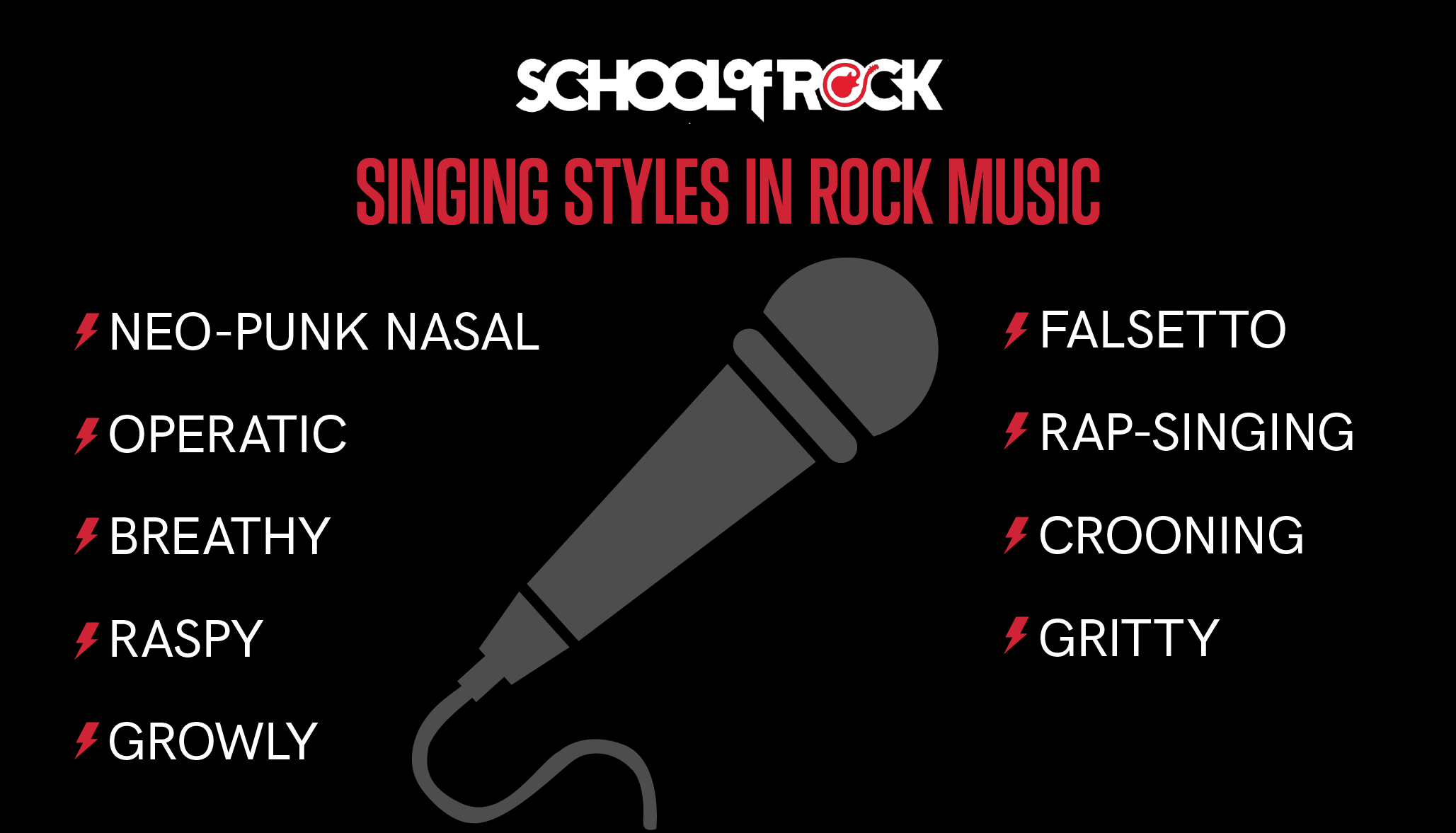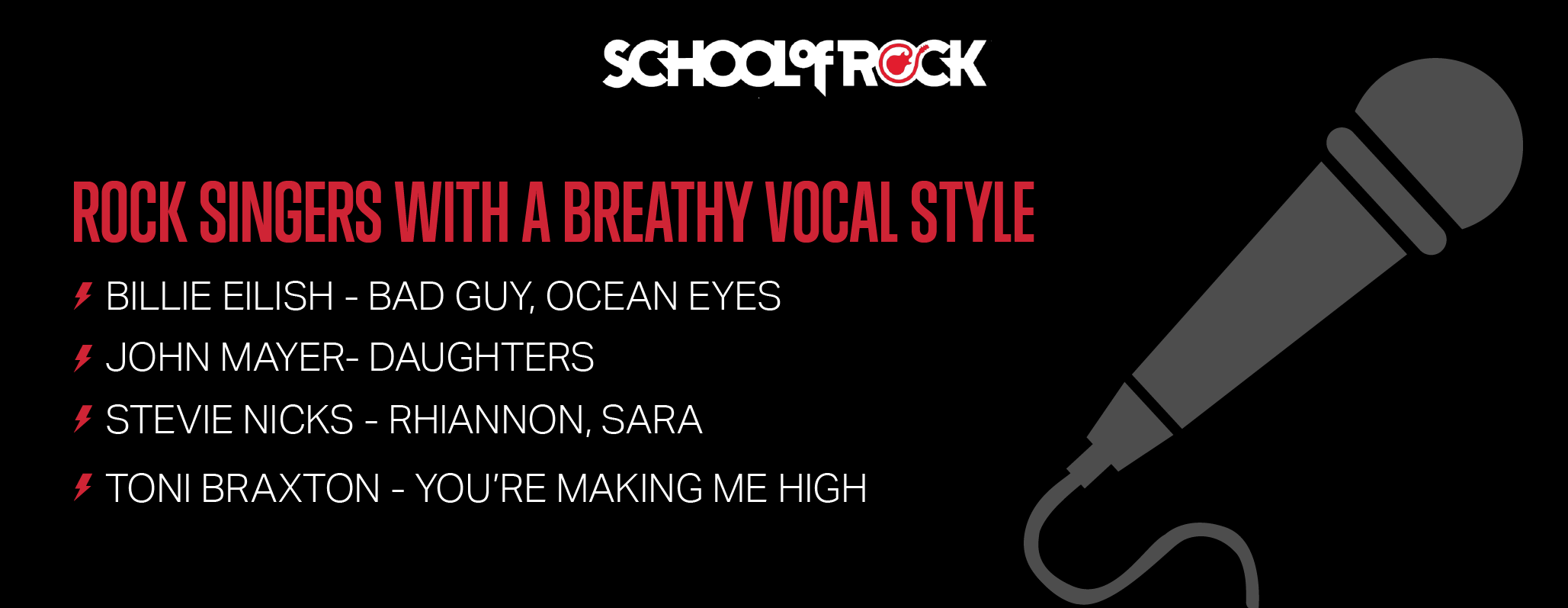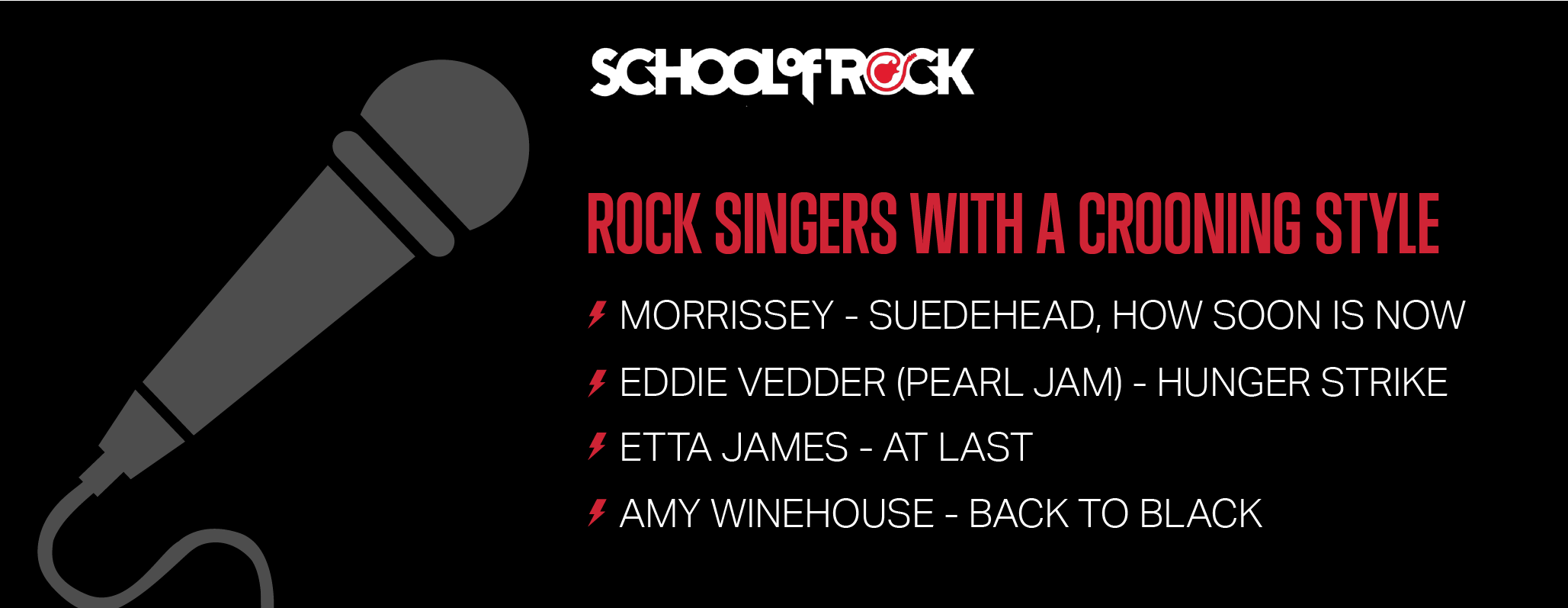“Everyone can sing, but we all need to
find out what makes our voice unique”
“Everyone can sing, but we all need to find out what makes our voice unique,” is something I repeat ad nauseam to my students. Over the past 6 years, I’ve had many beginning vocalists come into my studio telling me “they can’t sing” or “I'm a *this* kind of singer”. Singers will always put themselves into a box when they first start. Personally, I began as a classical vocalist solely because someone told me once that I could “make a career out of it [singing classically] if I wanted to”. As vocalists, we limit ourselves to what we can do by keeping ourselves from exploring our instrument. Rock, as a genre, is full of so many diverse vocal types that no matter what path you might follow, it’ll lead you somewhere underneath its umbrella.
How to find your rock singing style
The most important place to start your singing is from a place of joy. What music gets you excited to sing? What are the songs you sing along to in the car? The process of learning to sing is long and difficult, one that I’m still on, so you need to find the reluctant joy in the practice. If you’re not sure whether you or your child is ready to begin learning to sing, check out this article to learn the best age to start singing.
Once you begin your process, it’s time to start listening to some new music! While in school, I’d bring my own songs into my lessons with my teacher and say “It was inspired by so-and-so." My teacher would always encourage me to bring my lens a step back; who influenced my influences? You go back far enough and most, if not all, music goes back into 20th century Rock n’ Roll/RnB. When you broaden the scope of your musical world, you can begin to find a place you fit. When your musical ear grows, you can start to pull pieces from all the singers you gravitate towards.
The difference between vocal style and vocal range
Before we delve too deep into the diversity of vocal styles, we should first talk about “vocal range”. Every singer’s vocal range is different. There are many biological and environmental factors at play that will affect your voice (body type, hormones, musical exposure). “Range” boils down to the notes you can sing HEALTHILY (no forcing out high notes on my watch!) Understanding your range helps you learn what colors you have in your musical palette to express yourself. Through practice, persistence and technique, you can expand your range into higher or lower territory. Find out how to determine your vocal range here.
Vocal style on the other hand is made up of more nuanced categories. These can consist of tone and texture (more formally known as timbre) and the means of production (where is the sound resonating in your body?)
How vocal style and range work together
If we think about our range being our palette or colors, or vocal style is the brush and how we express them. You shouldn’t feel limited by your range. Your range is part of what makes your instrument unique. There are many things you can change to work around your range, such as changing the key of the song you’re singing in so it fits more comfortably in your voice. Once you’ve established where you’re working in your range, you can begin to express yourself in one of many different vocal styles.

Singing styles in rock music
While there are many different vocal styles in rock, not all of them will work for your specific instrument (and that’s okay!) The more trained your voice becomes, you may even begin to find yourself going in and out of these styles in just one song. Some styles may be used for pops of color or expression, while other styles may be omnipresent in your sound. Today we’re going to be discussing gritty, raspy and growly vocal textures, operatic, falsetto and neo-punk nasal techniques, and breathy or crooner qualities. Before we delve any deeper, the number one rule of singing is if it hurts, STOP! Be sure to work with a teacher before pushing your boundaries too far.
Gritty singing STYLE
A gritty sound is synonymous with rock music. It’s when a singer’s voice sounds like it’s been through a blender, but still is pleasant to listen to (like a milkshake full of chocolate pieces). Grit often comes from vocal abuse, whether that’s poor technique, strain or indulging in behavior not beneficial to the longevity of your vocal health. You can hear it in a lot of different styles: hair metal, blues, rock and roll. For some people, they use grit to emphasize a sound or lyric, while some just have grit naturally in their voice.
How to sing with a grit
BE CAREFUL when exploring a gritty sound. Often the sound originates when the vocal folds (commonly known as vocal chords) are meeting aggressively. This can cause the vocal folds to become calloused, creating vocal nodules which can cause permanent damage to your voice.
That being said, you can often find gritty textures in a voice while singing in a higher range. To begin exploring the sound, try growling like a dog or animal. Do this nice and relaxed without tensing your throat. Locate where you feel your sound vibrating. This distortion will be the base of your gritty sound.
Rock singers with a gritty vocal style
Here are some examples of singers with a gritty texture to their voices:
- Bon Scott (AC/DC) - “Highway to Hell,” “Dirty Deeds”
- Janice Joplin - “Piece of My Heart,” “Me and Bobby McGee”
- John Fogerty (Creedence Clearwater Revival) - “Fortunate Son”
- Alice Cooper - “Poison”
Operatic Singing Style
The operatic style of singing lends itself to a more robust sound with heavy vibrato and dramatic gusto. It’s a more dramatic way of storytelling. There are many rock operas as well such as The Who’s “Tommy.”
How to sing with an operatic style
I often tell my students that “the Italians perfected singing”. Italian opera is mostly associated with the “operatic” sound. This comes from using your chest as a resonator and using tall, dark vowels in your voice. Try placing your hand on your chest and saying “Bad Dog” as dramatically as you can. If you can feel your chest vibrating, then you’re doing it right.
Operatic technique is often the blueprint for healthy singing. However, voice strain is possible if you attempt to mimic operatic sounds without knowing the proper technique. You can sing consistently throughout a song in an operatic style, which may also lend itself to you traversing through your range with ease.
Rock singers with an operatic vocal style
Here are some examples of singers who use an operatic style:
- Bruce Dickenson (Iron Maiden) - “Run to the Hills,” “The Trooper”
- Freddie Mercury - “Bohemian Rhapsody,” “We Are the Champions”
- David Bowie - “Life on Mars”

Breathy
In today’s music, a breathy sound is very common. Breathy is when the singer allows extra air into their vocal production, diffusing the sound and giving it an airy quality. You’ll hear it a lot in more intimate songs and downplayed instrumentation like in an RnB ballad.
How to sing with a breathy style
Breathiness can work in all ranges, but is very common in the middle register of the voice. If you don’t know what breathiness sounds like in your voice, put your hand in front of your face and try “fogging a mirror”. Then, try doing the same exercise with a “Ha” sound.
While not particularly straining, breathiness can lend itself to an unsupported sound and enforce some bad singing habits, so make sure you establish a healthy technical base before using this in your singing.
Rock singers with a breathy vocal style
Here are some singers who use a breathy sound in their singing:
- Billie Eilish - “Bad Guy,” “Ocean Eyes”
- John Mayer- “Daughters”
- Stevie Nicks - “Rhiannon,” “Sara”
- Toni Braxton - “You’re Making Me High”
Raspy
A raspy sound is not too far off from a gritty sound. Both maintain a certain level of excess noise in the sound. While a gritty sound often comes into play with higher stakes singing, raspy can exist in a more intimate setting.
How to sing with a rasp
Much like grit, a raspy sound can develop from vocal abuse (i.e. smoking, excessive drinking etc.) and comes from your vocal folds meeting aggressively or inconsistently, creating friction. A healthy way to find a raspy tone in your own voice is to sing a siren down into your lowest register until you hit that gravely sound which we call “vocal fry”. From there, try reversing the exercise and start in your vocal fry while moving into your singing register. Experiment with the sound until you find a sound you like. Vocal fry isn’t especially damaging, but if your voice becomes tired, be sure to stop and hydrate.
Rock singers with a raspy vocal style
Here’re some examples of singers that use a raspy vocal style:
- Lana Del Ray - "Video Games"
- Macy Gray - "I Try"
- Stevie Nicks - "Rhiannon," "Sara"
- Amy Winehouse - "Rehab"
Growly
A growly sound can often be associated with a raspy one. A lot of excess noise, adding a texture to your voice.
How to sing with a growling style
Be careful when trying to add unnecessary texture to your voice. Forcing strain can cause long term damage for your voice. Similar to finding a raspy sound in your voice, experiment with your vocal fry in your sound.
Rock singers with a growling vocal style
Here are some examples of singers who can growl like an animal:
- James Hetfield (Metallica) - "One," "Enter Sandman"
- Billy Corgan (Smashing Pumpkins) - "Bullet with Butterfly Wings"
Neo-Punk Nasal
People often hear nasal and think “Ew, I don’t want to sound nasal. Nasal voices are so annoying!” I’m here to tell you that finding your nasal sound will open some really incredible doors for you. You’ll hear nasal sounds in singers who sit in their mid-high registers. It helps support a healthy belty sound.
How to sing with a nasal punk style
Before you start belting like a Broadway superstar, make sure you find your nasal placement. Put your fingers on the cartilage in your nose and meow like a cat. No, seriously. Look for the vibrations in your nose. Another exercise you can use is saying “cheese” like you’re posing for a photo. With practice, you’ll be able to use your nose like a pro and comfortable travel through your newfound high and belty range.
Punk rock singers with a nasal vocal style
Here are some singers that use the nasal sound in their music:
- Tom DeLonge (Blink 182) - “All the Small Things”
- Jordan Pundik (New Found Glory) - “Summer Fling,” “Don’t Mean a Thing”
- Gerard Way (My Chemical Romance) - “Welcome to the Black Parade”
- Patrick Stump (Fall Out Boy) - “Sugar, We’re Goin Down”
Falsetto
Falsetto is less a vocal style, but more a vocal placement. As your voice travels higher, you might find it more difficult to make strong sounds or sound at all! What we would do is flip into our “falsetto” to take the song higher. Falsetto comes in to play with a lot of artists, whether they sing the whole song in their falsetto or take it up for brief moments.
How to use falsetto
The trick to finding your falsetto is lifting your soft palate. If you take your tongue and rub it along the roof of your mouth, you’ll feel the front towards the teeth is harder and gets softer the farther you go back. A trick to finding the “lift” is to yawn and pay attention to the space created in the back of your mouth.
Once you get a sense of the space, try doing a big “Disney Princess” sigh. Another tool you can use is to do a lip buzz, starting lower in your range and taking it as high as you comfortably can. Pay attention to your sound, as you go higher, your voice will flip into your head voice. Practice these two exercises until you gain a better understanding of your head voice.
Rock singers often use falsetto
Here are some singers with excellent control over their head voices:
- Prince - “Kiss”
- Thom Yorke (Radiohead) - “Fake Plastic Trees,” “Creep”
- Freddie Mercury (Queen) - “Somebody to Love”
- Justin Hawkins (The Darkness) - “I Believe in a Thing Called Love”
Rap-singing
Rap-singing is exactly how it sounds. You’re singing quick lyrical phrases while making sure it’s both pitch accurate and articulate. Because the pace of the song is quicker than most, this style requires practice and agility.
How to use a rap-singing vocal style
Rap singing requires practice. The quickest way to master a rap-singing song is by slowing down the tempo and working your way back up. This way you can develop the muscle memory needed to both sing precisely and not stumble over any complicated lyrics.
Rock singers who use a rap-singing style
Here’s a list of artists who write and perform in a rap-singing style:
- Zach De La Rocha (Rage Against the Machine) - “Take the Power Back,” “Bulls on Parade”
- Les Claypool (Primus) - “Jerry Was a Racecar Driver,” South Park theme
- Michael Diamond (Beastie Boys) - “No Sleep Till Brooklyn”

Crooning
A crooner style finds its inspiration from the jazz and big band singers of the 20th century. It’s a smooth vocal tone with a lot of warmth in the sound. You can find the crooner sound in a lot of alt-rock bands of the ‘80s.
How to use a crooning singing style
To “croon” is a very healthy style of singing. What the sound calls for is a strong legato (musical line) and good support. The sound is placed forward, think of sending the sound right behind your top teeth. To help warm up the tone, try using the same “bad dog” exercise from the operatic section of this article. Using your chest as a resonator helps create a warm song with depth.
Rock singers with a crooning style
Here are a few rock artists who have adopted a crooner style:
- Morrissey - “Suedehead,” “How Soon Is Now” (with The Smiths)
- Eddie Vedder (Pearl Jam) - “Hunger Strike” (with Temple of the Dog)
- Etta James - “At Last”
- Amy Winehouse - “Back to Black”
Ready to find your SINGING style?
In one of School of Rock’s performance-based ensembles, you’ll be exposed to many different artists and genres of music. While forming your band in one of our performance programs, you’ll also be working with one of our vocal coaches one-on-one, as they help you learn the proper technique to master multiple vocal styles. Find a school near you today!
About the Author
Sam Graham is a singing instructor at School of Rock Williamsburg in Brooklyn, NY. He received his Master’s Degree in Contemporary Improvisation from New England Conservatory and just released his debut EP “Cries for Attention” in May of 2020.



